Bike Rack
The Use of Bike Racks in Park Design Has the Following 11 Advantages
Regular users of bicycles can get a variety of health benefits. Installing bike racks can also have a significant positive impact on your company, from promoting cycling to attracting more clients, saving money, and improving your company’s image. This page discusses several bike rack styles, their importance, how they enhance parks, and where to put them. You will be able to simply organize, arrange, and make efficient bike parking places after reading this.
Bicycle Rack Types
There are numerous varieties of bike racks. Each has a distinctive look and uses to keep in mind:
- U Bike Racks: This design is also referred to as an inverted U rack or a staple rack. Even though its design is the most straightforward, it yet has all the essential components for bike parking. A bicycle will be supported by this rack in two locations, keeping it upright. Riders can secure the frame and wheel to the rack using this device. The U rack is dependable and regarded as one of the safest. Other shapes than the U shape can still be categorized and used as U bike racks. Due to their design, these bike racks are the most frequently utilized because they can be positioned conveniently adjacent to destinations. Two bikes can fit on each rack, and numerous racks can be lined up to secure as many bikes as are required.
- Post & Ring Racks: Popular for bike parking, these racks offer sturdy support and good security for bikes. The height of the ring needs to be taken into account while using this rack. It could be challenging to secure a frame and wheel to the ring if it is too high.
- Wheel Pocket Racks: Bicycles are kept upright by additional support provided by bike racks with wheel pockets. The bicycles are also parked correctly inside the rack thanks to the wheel well. More bikes can fit in a space when the vertical heights are spaced out.
- Wave & Serpentine Racks: Cyclists can distinguish these racks by their fluid curves, which reassures them of their security and dependability. U-Locks that lock to both the frame and wheel are compatible with both round and square variants. To fit as few or as many bikes as a facility needs to comply with standards, they can also be equipped with loops.
- Bollard-style Racks: These racks are used to control access to bike-only parking spaces and trails while also giving bikers a safe place to park. They can be used as security or traffic barriers to assist control big crowds because they are strong and extremely visible. Different widths and designs are available for this kind of rack.
- Grid-style Racks: Traditional and simple to use, grid-style racks are a good option. The grid layout is perfect for parking lots with lots of bikes. The majority of variants are available with one or two sides. They are small and only suggested for temporary bike storage.
- Ingenious Racks: These are fresh takes on conventional bike racks. They give any location more character and security. They brought a twist to conventional bike rack designs for greater interest and safety.
- Decorative Racks: Decorative racks will give your space character and intrigue. They meet bike parking standards while being creative and entertaining.
These styles can all be helpful in different situations. But with so many choices, it might be challenging to choose the ideal one for your situation. You can reduce your options and stay away from typical bike parking rack errors by using the following advice:
The following factors should be taken into account when choosing a bike rack: High density, organization, bicycle friendliness, security, and value
Bicycles on organized racks are kept upright by being slightly spaced apart, preventing them from rubbing against one another or tumbling to the ground. Look for offset handlebars or bike docks to keep your wheels in place.
Bike-friendly racks take the security of the bike itself into account. Choose those that are U-lock compatible and have protective coatings to stop the frame from scraping against metal.
High-density racks will make the best use of valuable space. High-density parking that doesn’t compromise organization is what you need. To fit as many bikes into a space as feasible, look for structured racks with flexible configuration options.
Bicycle theft, which occurs more frequently than most people believe, is prevented by secure racks. Bicycle racks that pose a challenge to thieves will not be targeted by them for theft. Avoid hollow tubing and opt for tougher materials like steel. Verify that a U-Lock will completely encircle the bike’s frame, wheel, and rack.
Finding the ideal balance between price and quality is also crucial. Some features are necessary for functionality, while others add to the price without providing any real value.
Finding the ideal bike rack for you and your bikers might be aided by keeping these criteria in mind.
The Importance of Bike Racks
Bike racks merely promote biking. Biking has a lot of advantages, including health benefits, environmental advantages, financial savings, and more. Bike riding is a low-impact, enjoyable, and healthy type of exercise that is suitable for people of all ages. Riding to your destinations might be a simple addition to a regular routine. Bicycles are used by an estimated one billion people every day for transportation, entertainment, and sport. Cycling works all of the major muscle groups, thus it is a terrific way to work out your muscles.
Cycling can help you stave off major conditions including arthritis, depression, diabetes, heart disease, stroke, and some malignancies.
A two- to four-hour weekly bike ride is all it takes to see an overall improvement in your health. The advantages get better the more frequently you practice it. One of the greatest methods to lower your risk of health issues linked to a sedentary lifestyle is to ride your bike frequently. When you use it as a form of transportation, riding your bike substitutes the time you would spend sitting in a vehicle, bus, or train. Additionally, it improves your strength and endurance and can be as intense as you choose.
Cycling is mostly an aerobic activity, which works your heart, blood vessels, and lungs. Your general level of fitness will improve because you’ll breathe more deeply, perspire more, and feel warmer. Regular cycling has other health advantages, such as:
- Enhanced cardiovascular health
- Disease prevention or management
- Reduced anxiety and depression
- Strengthened bones
- Decreased body fat
- Improved posture and coordination
- Improved joint mobility
- Increased mental power
- Improved immune system
- Increased muscle strength and flexibility
- Decreased stress levels
Cycling has additional advantages for your health in addition to saving the environment. The same space as one car can accommodate twenty bicycles.
- Bikes don’t pollute. For the same amount of energy, you can move around three times as quickly as walking.
- Helps out at work. Exercise before or during lunchtime helped employees manage their time and task better. Additionally, it increased their resilience to stress and sense of motivation.
- Prevent pollution. Researchers discovered that compared to bikers and walkers, passengers in buses, taxis, and cars absorbed significantly more pollutants.
- Snacks that are guilt-free. In order to prevent hyponatremia, a condition brought on by consuming too much water without adequate sodium and resulting in sickness and confusion, you should raise your salt intake in the days before a major ride.
- Realize innovative breakthroughs. Exercise helps decision-makers like top CEOs, writers, singers, and artists overcome mental obstacles. Just 25 minutes of aerobic exercise, according to a study, can increase creative thinking.
- You’ll be glad you did. Any light to moderate activity releases endorphins, which naturally reduce stress and make you feel good.
- Prevents fatigue. Even a little period of physical activity helps fight weariness. Fatigue levels are directly reduced by exercise.
Places where people frequently go, like a grocery store, a school, or a workplace, can add bike racks to encourage people to put down their cars and pick up their pedals. All the advantages listed above for riders accompany that encouragement.
11 Advantages of Using Bike Racks in Your Design
Bike racks will enhance staff happiness and broaden your consumer base when you incorporate them into your design. Additionally, you’ll be able to utilize your space to the fullest. Here are 11 arguments in favor of making your
- Draw in more clients
You’ve undoubtedly already noticed bicycles passing your area. They will ride through if you don’t provide the necessary amenities for them. Cycling tourism and bicycle commuting are expanding trends, particularly in major urban areas. Riders are more likely to patronize nearby establishments, and since they are saving money on parking, maintenance, and petrol, they will also be more willing to spend. A tried-and-true strategy to draw consumers and increase sales is bike parking.
- Competitive Benefit
Bicyclists will automatically favor businesses that offer sufficient bike parking over those that offer little to none.
- Community Participation
Cities all across the world are promoting a variety of alternate modes of transportation. Local businesses have a significant impact on the culture and way of life in neighborhoods. Install bike racks to show that you are a strong leader who supports good infrastructure, lower carbon emissions, and healthier lifestyles.
- Develop Your Image
An organization’s brand is everything. Cycling is innovative and futuristic. Supporting it might strengthen a cutting-edge brand and promote reputation. By offering bike parking, you establish your image as a bike-friendly company, which is advantageous to the majority of customers. Standard bike parking is a good place to start, but you should also think about setting aside space inside for more secure storage or perhaps constructing an on-street bike station with tire pumps, tools, and a hydration station. With this, your company can present itself as eco-friendly and green.
- Healthy and Contented Workers
Cycling lowers risk of diabetes and heart disease by keeping individuals active and healthy. Cycling is a robust cardiovascular activity. It has also been demonstrated to stimulate creativity and enhance mental wellness. People are preferring to commute to work by bicycle in greater numbers. It’s even required in some places to provide end-of-trip bike parking for workers. Employees that are healthy and happy are more productive and take fewer sick days. Cycling as a means of promoting healthy lives benefits both managers and employees.
- Boost Parking Capacity for Minimal Cost
It can be difficult to park cars without sufficient space and access to the road. In contrast, there are more chances to include accommodations into a commercial area when using bikes because they are more adaptable and take up significantly less space. More people can fit on bike racks than can fit in a single parking place, both for staff and customers. A single bike rack can provide simple multi-bike parking with easy access to a building entrance. Additionally, it saves you a ton of money because constructing a bike rack is considerably less expensive than creating a parking area.
- Make Space Optimal
Without adequate infrastructure, it may be common to see bikers park in undesirable locations and link their bikes to nearby trees, fences, railings, or other site features. Traffic on the road or for pedestrians may be damaged or obstructed as a result. Planning ahead ensures that space be used more effectively to support a wider range of purposes. By installing a wall bike rack, you may save even more space. These vertical racks can be attached to a wall quickly and efficiently while saving space and offering a more secure choice for bike storage.
- Community Assistance
Growing support results from increasing popularity. Numerous neighborhood initiatives provide support for companies wishing to add bike parking at their locations. Government officials and community organizations can provide planning assistance and, in some cases, even free hardware and installation.
- Halt the Increase in Bicycle Theft
Bicycle sales had an unparalleled rise as a result of the COVID-19 pandemic, particularly in North America. In order to promote cycling and outdoor exercise while maintaining physical distance, more bike lanes were created. Due to the widespread shortage of bikes brought on by this increase in bike usage, bike shops were overrun by the surge in demand. Bike theft rose along with the rise in bicycle sales. A significant factor in bike theft was a lack of secure parking choices. Even one bicycle rack can help to reduce the frequency of thefts. Those who know there is a secure location to park their bicycle will also be more inclined to ride.
- Supply better and safer parking options
Unusual parking methods have probably been seen before. People will utilize many strange alternatives, such as fences, street posts, gates, railings, and trees, if there is not a sufficient and comprehensive network of accessible public bike racks. This is dangerous not only for the bike owner, but it also endangers the general public and might harm the things being used. Most riders will use alternatives that are more plentiful and of higher quality. By increasing visibility and security and providing safe parking options, you can reduce the risk of bike theft.
- Decoratively Appealing
You might picture a convoluted, inferior-quality, unsecurious eyesore when you hear the term “bike rack,” taking up valuable space. The opposite is true. Commercial bike racks of today frequently come in attractive designs while yet being quite useful. They have provided a selection of tough, useful, high-end bike racks for over 30 years. To outfit your facility with the ideal design to suit your particular needs, you can select from portable, ground-mounted, and loop bike racks. The quality of the bike rack, the kind and caliber of the lock, and the way the lock is used are the three main determinants of the security of bike racks.
The Best Places to Install Bike Racks
There are a few things to think about before you buy and install your bike racks. Your main goal should be to provide a space where cyclists can park their bikes conveniently and expect to be safe and protected for a short period of time, usually less than two hours. Bike storage, as opposed to bike parking, has its own unique considerations that must be taken into account. Secure parking for longer periods of time. However, adhere to the short-term secure and practical bike parking recommendations provided below.
Organized and designated
Even in places where only a few riders are present, issues can easily occur without appropriate and well-organized bike parking. These issues only get worse as the population gets denser. If bicycle parking alternatives are poor in quality, a biker will pick the best option available to lock their bike, which may include fences, street signs, trees, railings, and more. Ultimately, the most significant placemaking feature that affects a cyclist’s destination will be the availability of safe and convenient bike parking. Almost any location benefits from adding biker-friendly features, such as: multifamily housing; campuses of schools and universities; commercial enterprises; offices; parks, sidewalks, and other public amenities; public transit stations; hospitals; and car parking lots and garages, and other public areas intended for community use.
Parking Space for Bikes
Planning a bike parking space should keep the cyclist’s comfort and the bike’s protection at the forefront of your considerations. Bike racks can be placed in an accessible position to provide convenience. The nearest rack should be placed 50 feet or less from the building’s main door or the desired location. If the parking spot is positioned farther away, cyclists may decide to use closer alternatives like trees or fencing instead.
To make bike parking more appealing than vehicle parking, it should also be situated nearer the entrance than the closest parking space. This will support promoting cycling. Take into account the routes that cyclists will most likely take to get to your bicycle parking place. To ensure simple access, put it close to key routes of travel. If it is too far from bicycle travel paths, usage will decrease noticeably.
Security and Transparency
Usage rises as visibility rises. It will make it simpler for riders to find bike parking as they get closer to their destination. To accomplish this, use signage or bright colors to make the rack itself as noticeable as possible. The level of convenience can be increased by adding ground markings that point riders in the right direction.
Since it functions as passive surveillance, placing bike parking next to pedestrian traffic will give an extra layer of security by discouraging potential theft. Bicycle parking that is concealed from view, such as in alleyways or behind buildings, makes it easier for criminals to get past the lock’s security. Additionally, bike parking spaces should be visible from the final destination so that bikers can keep an eye on their bikes. They feel more secure as a result, and they are more likely to park in the designated space
The quantity of bike parking spaces
Numerous municipalities, cities, and other governmental bodies have established minimum ordinances or other requirements. The best methods for figuring out how many bike parking spaces are required are as follows. In a city’s public works or parks and recreation department, you can typically find bike parking guidelines and ordinances related to capacity, placement, and right-of-way. The following are the minimal parking specifications that the Association of Pedestrian and Bicycle Professionals (APBP) suggests:
- Hospitals/Health Care Facilities: One spot per 20,000 square feet of floor space. at least two spaces.
- Schools: One spot for each 20 kids that the facility can accommodate. at least two spaces.
- Colleges and Universities: One slot for every ten students in the maximum number of students allowed. two spaces, at least.
- Business Offices: One location per 20,000 square feet of floor space. two spaces, at least.
- Off-street parking garages/lots: one place for every 20 car spaces. six places at a minimum.
Plan for an additional half to one spot per volume in more urbanized or bike-friendly towns.
Installation of a Bike Rack
The main mounting choices for installing a bike rack on the sidewalk are:
- Ground mounting. The safest option is this. The feet of the rack are positioned a specific distance below the surface of the ground. The legs are then embedded and secured by a pour of concrete.
- Surface mounting With a surface mount, the rack is fastened to the surface using metal flanges and wedge anchors. It is advised to utilize tamper-proof hardware with this technique. This will make it harder for thieves to remove the rack’s anchors from the ground. Depending on the particular rack, the flange could be circular, square, or any combination of these.
- Rail mounting This includes numerous racks that are fastened to rails so they may either be fixed to the ground or left free-standing.
- Freestanding. These bike racks are surface-mounted and not fastened. Freestanding bike racks need to have an enclosed locking component.
Concrete is the safest and best surface material for mounting bike racks. Additionally, it is the cheapest. With concrete, in-ground and surface mounts are your best bets. There are two main ways to arrange racks on an asphalt surface. Create an in-ground mount first by drilling holes for the legs in the asphalt. After that, install the rack and pour concrete footings to support it. Utilizing racks on rails is the second choice. Either the rails are secured to the asphalt or the complete assembly is left freestanding. Pavers should be taken out, concrete footings should be laid, and the rack should be buried. Another choice is racks on rails, although pavers should not be used with surface mounts. The rack can be readily lifted off the ground by simply loosening them. The lock can then be removed from the rack, allowing a criminal to take the bicycle. Pouring concrete footings for an in-ground installation is the ideal choice for natural surfaces like dirt and grass. The second-best choice would be free-standing racks with rails.
Bike Racks Design Plan
The location of bike parking will impact how accessible it is and how much it is used. There are fewer or no useful spaces when things are put too closely together or improperly spaced. The main plan of your design should include enough space between the rack and any permanent objects, moving objects, including moving or parked autos.
Allow for the following in general:
- End and side clearance that allows for easy movement of bicycles into and out of the parking space.
- Access to the rack from all sides so that all available parking places may be utilised; • Enough space surrounding the rack for riders to access and safely lock the bicycle to the rack from the side.
Different placements will be required depending on how your bike racks are oriented in relation to these components.
It is advised to have the following when positioning bike racks parallel to walls or other objects:
- From fixed things, such as walls: 48′′ of setback with a minimum of 36′′
- From parking lots or roads: a 24″ setback
- A distance of 96′′ is required from walls to make aisles or provide paths for pedestrians on sidewalks.
- In between various racks: a minimum of 48′′ and a spacing of 72′′
It is advised to have the following when positioning bike racks perpendicular to walls or other objects:
- From walls and other stationary objects: a minimum of 36 inches and a maximum of 48 inches.
- From roadways or parked cars: a minimum of 24″ and a maximum of 36″
- A setback of 132′′ is required from walls to make aisles or permit paths for pedestrians on sidewalks.
- In between various racks: 48′′ between spaces, with a minimum of 36′′
How to Choose a Bike Parking Rack
The same cannot be said for all bike racks. To make the greatest decision when choosing a rack, consider the appropriate user and the installation location. When choosing bicycle racks, factors to take into account include: ease of use, support for the bicycle, security, capacity, function, quality of materials, and aesthetics.
There are many different types of racks available, and they vary in terms of security, size, spacing options, the number of bikes they can fit, and other factors. There are several necessary components for bike racks that can help you limit your options:
- The capability of locking the wheel and frame to the bike rack.
- Provides two points of support for the bicycle;
- Is resistant to cutting, bending, or deformation; and
- Securely mounts to the ground.
Following the tips above will help you quickly plan and install the appropriate number and kind of bike racks in the appropriate locations with enough room.
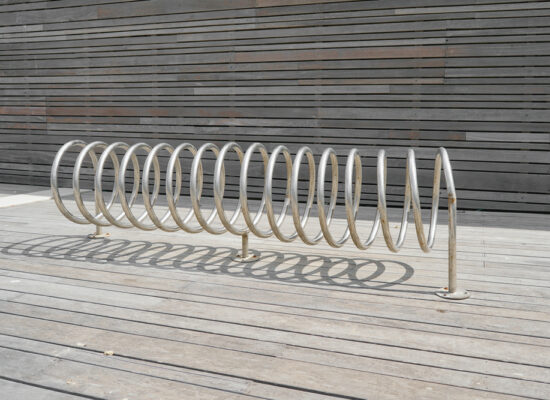
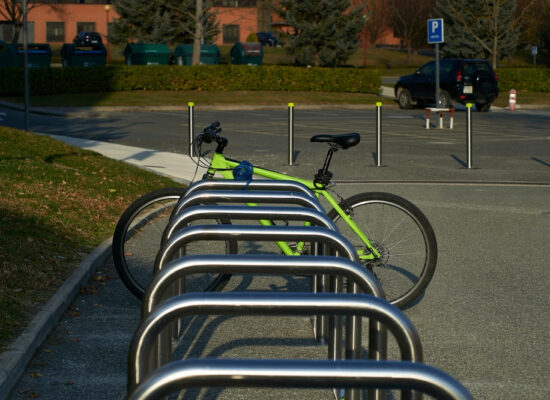
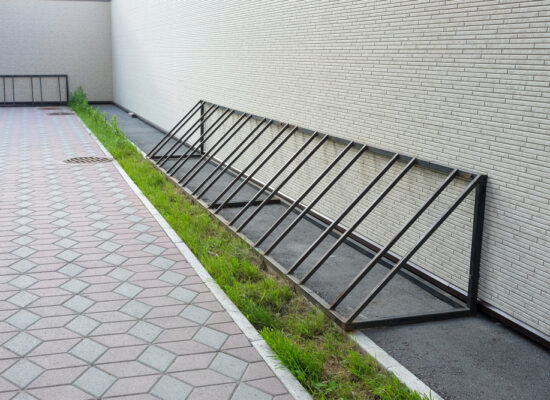
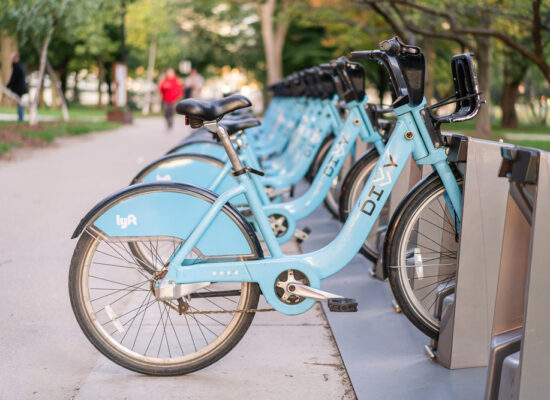
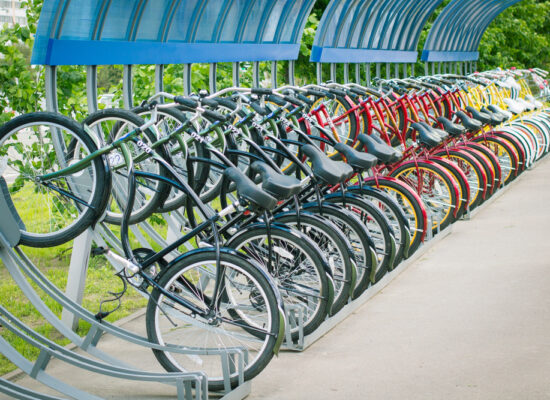
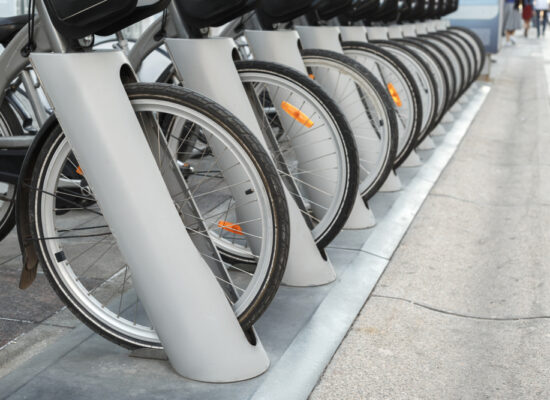
© Arbemu.. All rights reserved